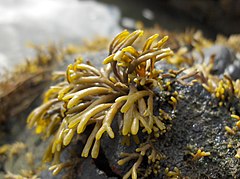Pelvetia
| Pelvetia canaliculata | |
|---|---|

| |
| Scientific classification | |
| Kingdom: | |
| Division: | |
| Class: | |
| Order: | |
| Family: | |
| Genus: | |
| Species: | P. canaliculata
|
| Binomial name | |
| Pelvetia canaliculata | |
Pelvetia canaliculata (L.) Dcne. et Thur. (channelled wrack) is a very common brown seaweed (Phaeophyta) found on the rocks of the upper shores of Europe.
Description
Pelvetia grows to a maximum length of 15 cm in dense tufts, the fronds being deeply channelled on one side: the channels and a mucus layer help prevent the seaweed drying when the tide is out. It is irregularly dichotomously branched with terminal, receptacles [1] and is dark brown in colour. Each branch is of uniform width and without a midrib. The receptacles are forked at the tips.
It is distinguished from other large brown algae by the channels along the frond. It has no mid-rib, no air-vesicules and forms the uppermost zone of algae on the shore growing at or above high water mark. [2] The reproductive organs form swollen, irregularly shaped receptacles at the end of the branches. The conceptacles are hermaphrodite and borne within the receptacles.
Ecology and distribution

P. canaliculata is the only large algae growing on rocks forming a zone along the upper shore at the upper littoral zone, on the shores of the British Isles. It tolerates a wide range of exposure conditions. [3] It needs periods of exposure to the air, and sometimes grows so high up a beach that coarse grass and other longshore angiosperms grow among it. If it is submerged for more than six hours out of 12 it begins to decay. [4]
Distribution
Pelvetia canaliculata is common on the Atlantic shores of Europe from Iceland to Spain, including Norway, Ireland, Great Britain, the Netherlands, France and Portugal. [5]
References
- ^ L. Newton (1931). A Handbook of the British Seaweeds. British Museum, London.
- ^ C. I. Dickinson (1963). British Seaweeds. The Kew Series.
- ^ J. R. Lewis (1964). The Ecology of the Rocky Shores. The English Universities Press Ltd. London.
- ^ D. Thomas (2002). Seaweeds. Life Series. Natural History Museum, London. ISBN 0-565-09175-1.
- ^ M. D. Guiry & Wendy Guiry (2006-10-25). "Pelvetia canaliculata (Linnaeus) Decaisne & Thuret". AlgaeBase.
{{cite web}}: Check date values in:|date=(help)
External links
- N. White (2006). "Channelled wrack, Pelvetia canaliculata". Marine Life Information Network for Britain and Ireland. Plymouth: Marine Biological Association of the United Kingdom.
- David W. Connor, James H. Allen, Neil Golding, Kerry L. Howell, Louise M. Lieberknecht, Kate O. Northern & Johnny B. Reker (2004). "LR.LLR.F.Pel: Pelvetia canaliculata on sheltered littoral fringe rock". The Marine Habitat Classification for Britain and Ireland Version 04.05. ISBN 1-861-07561-8.
{{cite web}}: Unknown parameter|publisehr=ignored (help)CS1 maint: multiple names: authors list (link) - British Isles Seaweeds Images
